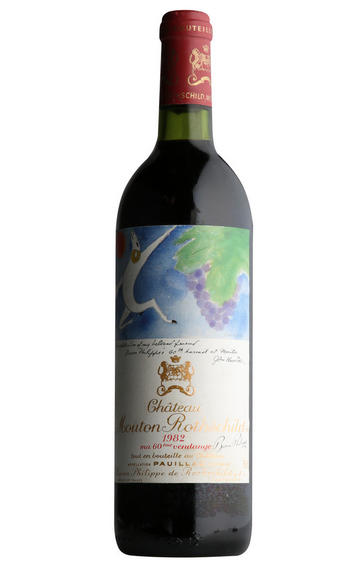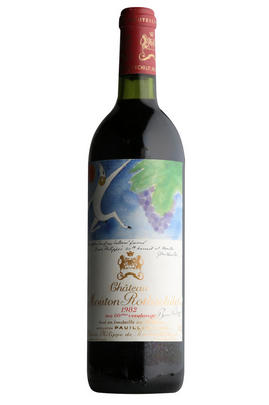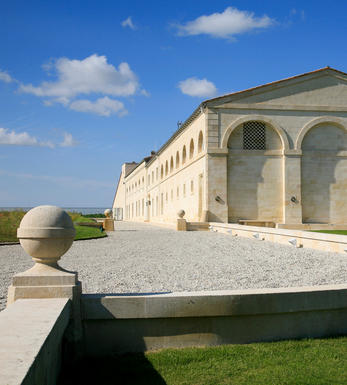
1982 Château Mouton Rothschild, Pauillac, Bordeaux

Critics reviews
This is one of the best bottles of 1982 Mouton-Rothschild that I have drunk. Intense and lavish on the nose, this bursts with blackberries, raspberry confit, wild mint and graphite aromas, yet there is a sense of calm and refinement, perhaps less VA that some examples. The palate is medium-bodied and beautifully balanced, with some of the finest tannins that I have noticed on this Mouton Rothschild. Slightly tertiary on the finish, it builds and builds and leaves you utterly smitten. My God, dare I say it almost reminds me of L****r?
Drink 2023 - 2050
Neal Martin, Vinous (September 2022)
Sweet, round and absolutely gorgeous at this point, with a perfect level of spiciness. Just lovely now.
Drink now to 2032
Jancis Robinson MW, JancisRobinson.com (April 2023)
The vintage with the label designed by film director John Huston. Enjoyed alongside a bottle of 1982 Ch Latour with grouse.
This wine with a little hint of brown in the hue was extremely sweet and opulent but seemed more evolved and very slightly less focused than the Latour. The acidity and sweetness seem in danger of detaching themselves from each other. There's the leathery note – verging towards 'old ladies' handbag', as someone once described the nose of Mouton. It would probably have shown even better if there had been no Latour 1982 with its extra freshness and potential alongside. It was certainly a treat.
Drink now to 2030
18/20 - Jancis Robinson MW, JancisRobinson.com (September 2020)
Over the last couple of years, I had inclined to the view that the 1986 vintage was eclipsing the 1982 Mouton Rothschild, but two perfectly conserved bottles this year put paid to that hypothesis. One of the emblematic wines of the vintage, offering up aromas of sweet crème de cassis, cigar wrapper, espresso roast, spices and vine smoke, it's full-bodied, broad and enveloping, with a rich core of fruit; ripe, supple tannins; and a long, expansive finish. Lavish, even flamboyant, and at the same time seriously structured and quintessentially Mouton, it encapsulates the greatness of the vintage. For readers interested in numbers, the 1982 attained 12.3% alcohol with a pH of 3.64 (that information is the result of a great personal misfortune, because I sent a sample from a tragically corked magnum to the local enology lab for analysis out of curiosity).
Drink now to 2045
William Kelley, Wine Advocate (December 2022)
What an amazing red. It's so very youthful with toasted oak, light vanilla, and dark berries such as currants and blueberries. Then it turns to mint. This is so fresh and intensely fruity. It lasts for minutes on your palate with each sip. It is so powerful yet elegant. It will improve for hundreds of years. I would still leave it in my cellar for five or ten years. If you need to drink it, decant it three to four hours in advance.
James Suckling, JamesSuckling.com (November 2010)
About this WINE

Château Mouton Rothschild
Classified as a First Growth, Château Mouton Rothschild has a long and storied history; wine has been made here since Roman times. The property spans 82 hectares of vines in Pauillac, planted with the classic varieties of the region, Cabernet Sauvignon being predominant.
The estate has been in the Baron Philippe de Rothschild family since 1853, but it wasn’t until the arrival of Baron Philippe de Rothschild in 1922 that its fortunes were transformed. Baron Philippe was a dynamic figure who revolutionised the estate and was the first to introduce château-bottling in 1924. He also introduced the concept of commissioning an artist to design each new vintage’s label. Some of the most notable contributors include Salvador Dalí, Henry Moore, Marc Chagall, Francis Bacon, Lucian Freud, Anish Kapoor and Peter Doig.
His daughter Baroness Philippine continued to help raise the estate to new heights with numerous endeavours, including the inauguration of a new vat house in 2013. Today, her three children, Camille and Philippe Sereys de Rothschild and Julien de Beaumarchais de Rothschild, continue the efforts of their predecessors.
Following the retirement in 2020 of Philippe Dhalluin, the winemaking team is now headed up by Jean-Emmanuel Danjoy. With his team, he oversees over 83 hectares of vines, planted with Cabernet Sauvignon (78%), Merlot (18%), Cabernet Franc (3%), and Petit Verdot (1%). The average age of the vines is around 50 years.

Pauillac
Pauillac is the aristocrat of the Médoc boasting boasting 75 percent of the region’s First Growths and with Grand Cru Classés representing 84 percent of Pauillac's production.
For a small town, surrounded by so many familiar and regal names, Pauillac imparts a slightly seedy impression. There are no grand hotels or restaurants – with the honourable exception of the establishments owned by Jean-Michel Cazes – rather a small port and yacht harbour, and a dominant petrochemical plant.
Yet outside the town, , there is arguably the greatest concentration of fabulous vineyards throughout all Bordeaux, including three of the five First Growths. Bordering St Estèphe to the north and St Julien to the south, Pauillac has fine, deep gravel soils with important iron and marl deposits, and a subtle, softly-rolling landscape, cut by a series of small streams running into the Gironde. The vineyards are located on two gravel-rich plateaux, one to the northwest of the town of Pauillac and the other to the south, with the vines reaching a greater depth than anywhere else in the Médoc.
Pauillac's first growths each have their own unique characteristics; Lafite Rothschild, tucked in the northern part of Pauillac on the St Estèphe border, produces Pauillac's most aromatically complex and subtly-flavoured wine. Mouton Rothschild's vineyards lie on a well-drained gravel ridge and - with its high percentage of Cabernet Sauvignon - can produce (in its best years) Pauillac's most decadently rich, fleshy and exotic wine.
Latour, arguably Bordeaux's most consistent First Growth, is located in southern Pauillac next to St Julien. Its soil is gravel-rich with superb drainage, and Latour's vines penetrate as far as five metres into the soil. It produces perhaps the most long-lived wines of the Médoc.
Recommended Châteaux
Ch. Lafite-Rothschild, Ch. Latour, Ch. Mouton-Rothschild, Ch. Pichon-Longueville Baron, Ch. Pichon Longueville Comtesse de Lalande, Ch. Lynch-Bages, Ch. Grand-Puy-Lacoste, Ch, Pontet-Canet, Les Forts de Latour, Ch. Haut-Batailley, Ch. Batailley, Ch. Haut-Bages Libéral.

Cabernet Sauvignon Blend
Cabernet Sauvignon lends itself particularly well in blends with Merlot. This is actually the archetypal Bordeaux blend, though in different proportions in the sub-regions and sometimes topped up with Cabernet Franc, Malbec, and Petit Verdot.
In the Médoc and Graves the percentage of Cabernet Sauvignon in the blend can range from 95% (Mouton-Rothschild) to as low as 40%. It is particularly suited to the dry, warm, free- draining, gravel-rich soils and is responsible for the redolent cassis characteristics as well as the depth of colour, tannic structure and pronounced acidity of Médoc wines. However 100% Cabernet Sauvignon wines can be slightly hollow-tasting in the middle palate and Merlot with its generous, fleshy fruit flavours acts as a perfect foil by filling in this cavity.
In St-Emilion and Pomerol, the blends are Merlot dominated as Cabernet Sauvignon can struggle to ripen there - when it is included, it adds structure and body to the wine. Sassicaia is the most famous Bordeaux blend in Italy and has spawned many imitations, whereby the blend is now firmly established in the New World and particularly in California and Australia.


Buying options
Add to wishlist
Description
This is one of the best bottles of 1982 Mouton-Rothschild that I have drunk. Intense and lavish on the nose, this bursts with blackberries, raspberry confit, wild mint and graphite aromas, yet there is a sense of calm and refinement, perhaps less VA that some examples. The palate is medium-bodied and beautifully balanced, with some of the finest tannins that I have noticed on this Mouton Rothschild. Slightly tertiary on the finish, it builds and builds and leaves you utterly smitten. My God, dare I say it almost reminds me of L****r?
Drink 2023 - 2050
Neal Martin, Vinous (September 2022)
wine at a glance
Delivery and quality guarantee